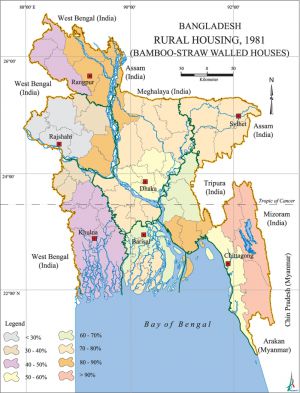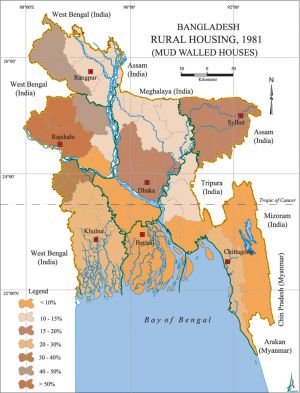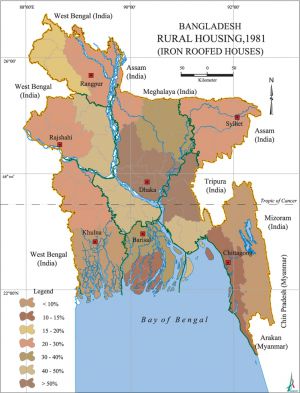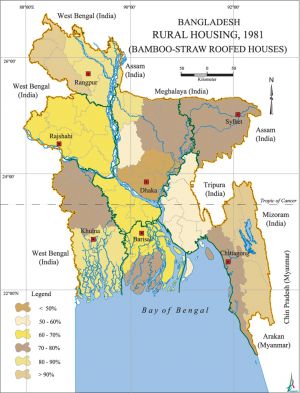Rural House
Rural House Construction and distribution pattern of housing in a certain region develops according to the need of the inhabitants under a set of geographic control and changes with the evolution of the human needs at the different stages of the socio-economic and cultural development. Landform is one of the major criteria in selecting housing site. As the major portion of Bangladesh is almost flat and deltaic terrain, the inundation and flooding in monsoon forces houses to be sited on higher ground or to raise the land artificially, as in the haor areas. The levees form most of the high ground available in the deltaic areas or in the low basins.

Social and economic factors like the income, status, size of the family and besides, cultural practices determine the size, design and form of houses, particularly, in terms of orientation or location of individual housing units and of utility. For example, sleeping units in the households are made south facing while kitchens are constructed west-facing. Room number depends mainly on the socio-economic status and also the size of the family. Rooms are of different sizes and shapes, though rectangular are the common shape in the country. Around a rectangular or square courtyard, rooms are constructed. In northern and mid-western parts of the country, there is a tradition of having inner and outer courtyards. Pond is an important part in the villages of Bangladesh. Perennial tree surrounding the houses are a common picture in almost all rural areas of the country. For ensuring privacy of the household, every house normally has fencing made of bamboo or palm leaves or straw or corrugated iron (CI) sheets etc.
Rural houses are mainly made of indigenous materials locally available, such as, bamboo, straw, grass, jute stick, Golpata' [Golpata] (Nipa fruiticans), mud and CI sheets. Different combinations of them make the main type. But the most common material for making the walls is bamboo. Of bamboo walled houses the commonest are those with walls of thinly spliced bamboo, plaited into square of diamond pattern. In the piedmont alluvial plains especially in Rangpur, and moribund delta area in Jessore, Haor basin, Ganges, Tista, Brahmaputra-Jamuna and Meghna floodplains and in some areas in eastern and northern regions, the houses are mainly bamboo-walled with thatched curved roof built on high plinth.

The roof of the houses is normally thatched with CI sheet; with Son' [Shon] grass (Imperata arundincca) in northern central and eastern regions; with Ulu (Saccharum cylindricum); Khari (S. fuscum) and Bena grasses over most of northern and central regions and the north of southern regions; with golpata leaves in the south of the southern region and the southern coastal tract of Chittagong district; with Tal' [Tal] (Borassns flabellifer) leaves over much of the Madhupur and Barind Tracts; and with paddy straw by the poorest all over the country. Shapes are predominantly oblong. A small verandah' [baranda] with wood or bamboo support is the common design. Plaited bamboo dubbed on with a thick layer of mud used for the wall is found in the housing construction in southwestern parts of northern Bangladesh. The same of housing style is also common in the islands and the coastal regions of Chittagong, especially on the south of Sitakunda. In the rural areas in and around Dhaka, Narayanganj, Chandpur and Pabna, bamboo wall houses with CI sheet roof are quite common.
A long patch of landform running from Dinajpur, Bogra to Jessore and some parts of Khulna following the western side of the country has a distinctive characteristic of mud-walled houses. Oblong shaped mud-walled houses with thatch and tile roof are common in Bogra, Pabna, Kushtia and Jessore. In Chapai Nawabganj, the roof of the mud-walled house is moulded by brick-dust mixed with lime, which is peculiar to only this area. Besides, in the region from Bogra to Kushtia, mud-walled houses with CI sheet or kerosene tin roof is another common type. The mud is dried in the form of block for building houses. The gapes between the blocks are filled in with clay. Along with the land-level which normally remains above flood level, relatively less rainfall and dry climate, and lateritic soil (which get very hard when dry) are some of the main causes of the development of mud wall in the housing structure in these areas. Mud-walled houses with two to three levels of roof are common in Chittagong region. The roofs are often thatched with CI sheet. In the Madhupur area, mud-walled house with long grass-thatched roof is common. This type of house is also common in northern and western Dhaka and south of Tangail but with CI sheet roofing.

Timber houses are common in certain parts of the country eg Madhupur Tract, Chittagong Region, where there are forests nearby. Except in the southern Chittagong district, these timber houses are invariably double-storied. The front is often curved and painted. In the southern Chittagong district the houses of the Rakhaing, Moghs are also of timber, but on stilts and usually one storied. The prosperous Moghs have double-storied houses with curved balconies and lintels. Sylhet district has a distinctive half-timber type of houses. The floor and sometimes part of the lower walls are usually of brick construction. The walls are of Ikra (Erianthus ravaneae) reeds or bamboo matting plastered over with cement or mud on both sides and painted white; a frame of timber, painted black holds these up. The roof is usually of CI sheets, and sometimes of straw. This type is common to the eastern parts of Sylhet district
A house made of corrugated iron sheets is very prestigious in rural areas. Variations in the design, size and height of the CI sheet-built houses are related with the status and wealth of the family. Roofs with four facets of CI sheets, chouchala' [chouchala] and with two facets, dochala' [dochala], show two major variations in the design and indicate the status of the owner in the rural society. The high roofed chouchala with an attached verandah is aesthetically more attractive than a same size of dochala house. Windows are generally higher than those of mud or bamboo or straw walled houses. The plinth of these types of houses is sometimes made of cement. In Sylhet region, especially in the northern part, which experiences heavy rainfall in the country, houses with CI sheet roofing are common. The development of this type of houses perhaps owes its origin with the British colonial tradition when such houses were built in the tea plantations. The walls are made of either CI sheets or bricks. In Faridpur, Madaripur, Barisal, Patuakhali and Bhola CI sheet houses are also common where it is used both for roofing and wall construction. In central part, as in Dhaka, Comilla and Mymensingh it is mainly used for roofing with mud or mud block wall. But nowadays, CI sheet walled and roofed houses are commonly observed all over the country.

Along the major rivers, where the areas are floodprone and subject to various hazards, like, riverbank erosion, people are compelled to invest as little as possible in housing. Very often their houses have walls of jute sticks with mud dubbed on and thatching of paddy straw which can be dismantled in hazard events. In the Haor basin, Chalan Beel area and in the char lands, cheap construction materials like reeds, long grass, jute sticks etc are widely used both for roofing and wall construction. This is so because of the availability of reeds and long grasses in the char lands and in the beel areas.
Kitchens, cowsheds, poultry-coops, etc are built separate and are usually of poorer material. Kitchens are rarely roofed with anything but thatched and have often a quarter to one-eighth the floor space of the dwelling houses. Cowsheds are built very poorly in almost all over the country. In the northwestern part of the central region, the cowsheds are thatched well and stand higher than the poor sheds common in other areas. Only in the moribund delta do the cowsheds have a distinctive design. They are long and low, with a slightly curved roof.
The tribes in the chittagong hill tracts (CHT) have their own distinct types of housing. The subculture of the tribes is reflected in the distinctive impact of landform on the economy and habitat of the tribal population which are significantly different from those in other parts of the country. In the forested hill districts of Chittagong division in order to ensure safety from ferocious animals, houses are built on high platform made of timber and bamboo with an open platform or veranda on one side. For climbing up, there is a notched log or a bamboo ladder. Bamboo pieces are used in flooring and the roof is made of split bamboo matting or with palm leaves or long reeds. The wide use of bamboo in house building is facilitated by the abundant growth of bamboo in this part of the country. The Lusai, Panko and Bom used to have houses with wooden floors and sometimes log walls. At the Garo foothills, the houses are made of bamboo, wood with grass thatched roofing built on a high platform similar to those in the tribal settlements in CHT. Nowadays, the traditional type of housing of the tribal people is dying out as the cultural assimilation is going on with the plain land culture. [Md Mahbub Murshed]
See also architecture, rural.
Bibliography Sirajul Islam Chowdhury, Arthanitik Bhugol: Visva O Bangladesh (in Bangla), Dhaka University, Dhaka, 1988; Haroun Er Rashid, Geography of Bangladesh, University Press Ltd, Dhaka, 1991; Sabiha Sultana, Rural Settlement Pattern in Bangladesh, Graphosman, Dhaka, 1993; Abdul Baqee, Grameen Bashati (in Bangla), Banga Prokashane, Dhaka, 1998.
